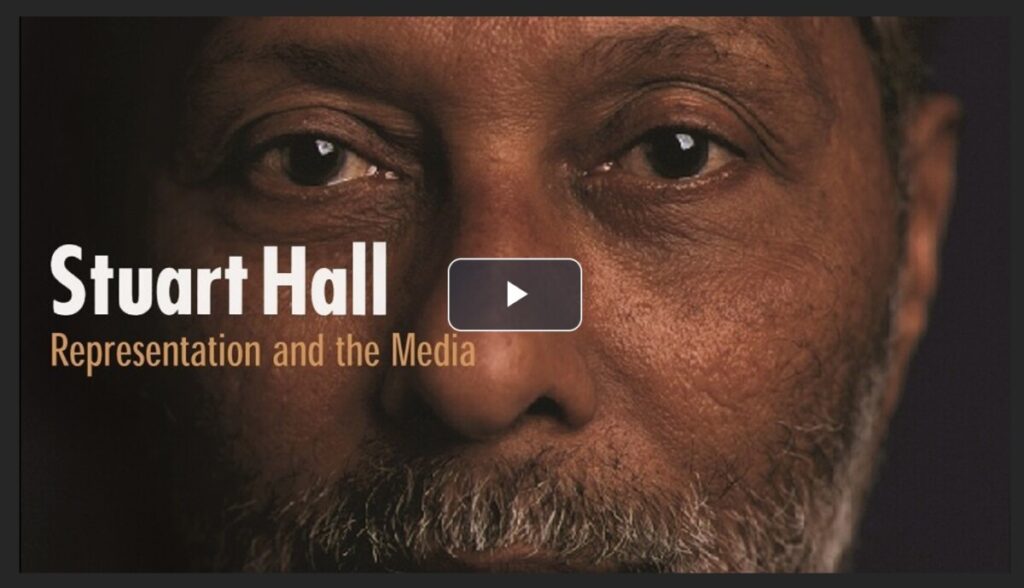In this section, we will look at representation and context by exploring the use of stereotypes in media (print, radio, television, and online advertisements).
In preparation, we return to Saussure (sign, signifier, signified) and Peirce (symbol, icon, index) to refresh our understanding of early semiotics. We will incorporate the terms from Barthes (connoted, denoted, iconic messages, linguistic messages) and explore additional terms such as encoding, decoding, polysemic, myth, and naturalization. Lastly, we will look at Jamaican-born cultural studies scholar and activist Stuart Hall who explored how the dynamics of media representation reinforce societal power structures.
Terminology
Review the semiotic terms we will need to deconstruct an advertisement.
Ferdinand de Saussure
- Sign: A sign is anything that creates meaning composed of a signifier and a signified.
- Signifier: A word, an image, a sound, anything we see, speak or hear to refer to the sign.
- Signified: The concept that our mind conjures in relation to the sign.
Charles Sanders Peirce
- Icon: signifier resembles the signified
- Symbol: arbitrary learned relationship between the signifier and signified
- Index: signifier is caused by or linked to the signified
Roland Barthes
- Encoding: creating a message for transmission (i.e., creation and distribution of an advertisement)
- Decoding: the process of interpreting a message (i.e., watching and interpreting an advertisement)
- Connotation: symbolic or cultural meaning (a coded message)
- Denotation: Literal meaning (a message without code)
- Linguistic message: words used to convey meaning
- Non-coded iconic message: an image with literal meaning
- Coded iconic message: an image with a coded message
- Polysemic: a sign that has multiple meanings
- Myth: a widely accepted meaning of a sign
- Naturalization: in a society, the repeated use of signs shapes its meaning
Stuart Hall
Stuart Hall was a Jamaican-born British sociologist, cultural theorist and political activist. He looked at the power of mainstream media (advertising, TV, film, etc) to understand the representation of race, gender, class, ethnicity, and religion. Here are some of the theories and terms associated with his work.
- Reception Theory: This theory asserts that advertising and media are encoded and decoded. The creator encodes messages and values into media which are then decoded by the audience. Audiences will decode the media in different ways and not always in the way the creator intended.
- Dominant, or Preferred Reading: how the creator wants the audience to view the advertisment or media.
- Oppositional Reading: when the audience rejects the preferred reading, and creates their own meaning. This can happen when content is controversial or when the audience holds different beliefs or is of a different age or culture.
- Negotiated Reading: a compromise between the dominant and oppositional readings. The audience accepts some of the creator’s view, but also has their own views.
- Representation Theory: There is not a true representation of people or events in media. Designers/creators try to ‘fix’ a ‘preferred meaning’ through ideology or stereotyping. Historically, this is driven by people in power.
Hall’s Reception Theory (6 min)
Hall’s Representation Theory (3 min)
Hall’s Representation Theory in detail (7 min)
In this 55 minute documentary from 1997, Stuart Hall offers an extended meditation on representation. Take a close look at 36:00 he speaks about representation in advertising. Note that this video was created is prior to social media and the internet era that we live in now. Consider if the power structure has changed and why/why not? Make sure you are logged into CUNY SSO (single sign-on) to view.

Stereotype in Advertising Media
The use of stereotypes to communicate meaning and sell products has a long history in advertising media and visual communications.
Mainstream media is a powerful force for intentionally or unintentionally reinforcing biases in society. It’s changing, but women and BIPOC designers in advertising are historically limited. That lack of diversity in creative leadership has allowed widely-held biases to continue to flourish.
History of racial, gender, ethnic, cultural stereotypes in advertisements
Review some of the links below to explore the use of racial, gender, ethnic, cultural stereotypes in advertisements.
- Race and Ethnicity in Advertising
- African Americans and Advertising – Marya McQuirter, Digital Curator
- Chinese Americans and Japanese Americans in Advertising :: Full Essay PDF
- Cultural Transformation and Chinese Figures in Nineteenth Century American Trade Cards – Lenore Metrick-Chen, Drake University
- European Americans and Advertising
- Jews and American Advertising – Eli Diner, University of California, Los Angeles, and Hasia Diner, New York University
- Latinos and Advertising – James Rodriguez, New York University
- Native Americans and Advertising – Stephanie A.L. Molholt, Community College of Baltimore County
- Sexuality, Race and Ethnicity in Advertising :: Full Essay PDF
- South Asian Americans in Advertising :: Full Essay PDF
Activity
Using Barthes’, Saussure’s, and Peirce’s semiotic terms and after reviewing the videos above, consider how the meaning of the image and text are used in advertising. How do racial, ethnic, and/or gender stereotypes affect the meaning?
- Identify the linguistic message(s).
- Identify the non-coded iconic messages.
- Identify the coded iconic messages.
- Identify the denotative and connotative aspects.
- Explain if the signs are icons, indexes, or symbols.
- Consider the cultural codes being conveyed in the advertisement.
- Identify if polysemic signs, myths, or naturalization can be observed.
Readings and Other Media
Use Hypothesis to annotate as you read the texts. See Using Hypothesis for details.
- Hall, Stuart. “The Whites of Their Eyes: Racist Ideologies and the Media” Selected Writings on Race and Difference, 1981
- ‘Ethnicity is authenticity’: how America got addicted to racist branding
- The Crying Indian, Ginger Strand, Orion Magazine (truth in advertising/greenwashing)
- Blackface and the Birth of the American Stereotype
- The Racism of 19th Century Advertisements
- The Real and Problematic History Behind Aunt Jemima
- “Ethnic Notions: African American Stereotypes and Prejudice” (Documentary 1987)
- Gender Advertisements (1979 book by the sociologist Erving Goffman with analysis of hundreds of US ads for gender roles)
- Food Is Love : Advertising and Gender Roles in Modern America, Parkin, Katherine J., 2007. ProQuest Ebook Central, (Book. Use your Library Card to access)
- Gender roles in 1940’s Ads (examples from cinema advertisements)
- Reelblack TV, YouTube Channel with many vintage ads, programs, and other media highlighting black representation in media: https://www.youtube.com/user/reelblack/featured
- Vice News, The History of Asian Representation in Film: https://www.youtube.com/watch?v=k5KwDTXWgSA
- Fonts in Use, Reproductions of You Don’t have to be Jewish Campaign (maybe interesting for historical context): https://fontsinuse.com/uses/14355/levy-s-ad-campaign-you-don-t-have-to-be-jewis



